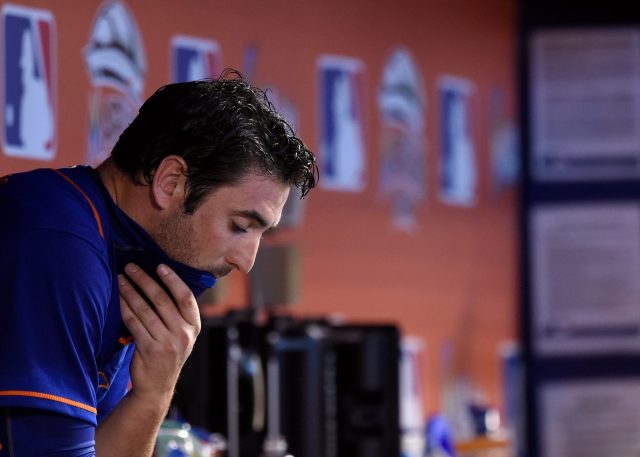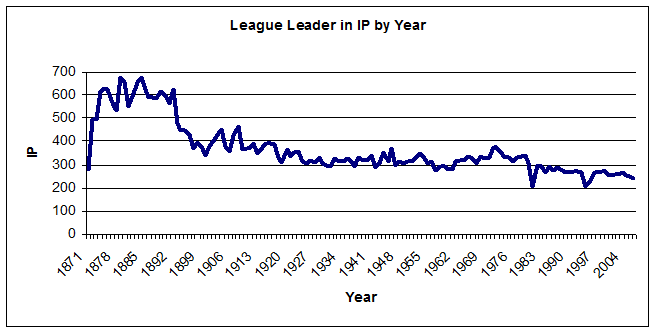The New York Mets’ Flailing Bullpen Can Be Helped By Starters

The New York Mets could solve their bullpen problems by tackling a different conundrum: starter usage.
[dropcap]T[/dropcap]hroughout the history of baseball, one thing has remained clear: Good pitching beats good hitting. Always.The impact of this phenomenon is tough to oversell: From the dead-ball era to the steroid era and everything in between, rosters comprised of premier pitching typically outperform rosters devoid of it.
While good pitching and success still have a strong correlation — the top seven teams by E.R.A. all made the playoffs last season — effective pitching is no longer what it used to be. And for teams like the New York Mets, the effects are already starting to show.
[sc name=”Mets Center” ] [sc name=”Mets Links” ]“When does innovation turn into regression?”
That’s what my brother, exhausted from the Mets’ fourth consecutive late-game implosion, asked on Tuesday night. Following a successful five-game winning streak, New York relievers wasted stellar performances from their prized starters.
On Friday night, in the first game of a three-game tilt with the Marlins, lefty specialist Josh Edgin faltered in the ninth. The next night, Fernando Salas surrendered three in the eighth, as the Mets relinquished a 4-2 lead. Less than 24 hours later, Addison Reed was hammered en route to a walk-off blast.
Finally, the Mets’ week in hell concluded the way it started: with the floundering bullpen giving up the tying run in the eighth, and blowing it in extras. Considering that the bullpen should be in the upper echelon of the league according to advanced metrics, this is a little frightening.[sc name=”The MetsCast Right” ]
Here’s a synopsis: fingers can be pointed at anybody and everybody — from Terry Collins to Jose Reyes to even the team’s relievers — but at the end of the day, if we’re playing the blame game, then much of the bullpen’s struggles are a bi-product of a sport that keeps on changing.
Said Elden Auker, a pitcher for the Detroit Tigers in the 1930s, ”Pitchers today are only expected to pitch into the sixth inning,” which is a seismic shift from the days in which starters routinely went seven or eight.
In fact, the league average for complete games was three last season. In 2000, which was already considered to be on the downturn, the league average was eight. And that’s for an entire team. Forget about individual pitchers; they used to finish fifteen, twenty games at ease. Now… well, it’s an entirely different story.

Those who acknowledge that this is an issue — that starters lasting only six places the brunt of the workload on relievers — usually point to one of two theories: first, that pitchers are coddled as a precautionary measure, and second, that managers have become too eager to get to their bullpens.
In a revealing interview with Benjamin Hoffman of The New York Times, former Mets pitching coach Rick Peterson discussed both theories.
When asked about high pitch counts, he summed up his view and the view of many others: ”Injury is a factor of poor deliveries, poor conditioning and overuse; it’s that simple,” he said.
Peterson wasn’t talking about Terry Collins’ view, but he might as well have been. What does this mean for the Mets? The best way to avoid more of these late-game collapses would be for the starters to go deeper into games.[sc name=”Mets Center Right” ]
But there’s a problem with this: most simply don’t know how to anymore. When a pitcher hasn’t been taught to pitch into the seventh or the eighth, fatigue will set in, whether the team likes it or not.
But there’s another view that Peterson also addressed. It’s possible, he said, that managers could be embracing their bullpens — so much so, that they’ll actually take their starters out just to get to the ‘pen earlier.
”If you’re going to complete the game, you’ve got to go through the middle of that lineup four times,” Peterson said. ”There are very few pitchers that have the quality to go through the middle of the lineup four times. The advantage is having someone who has a different dimension than your starting pitcher to go through the middle of that lineup sometimes for the fourth time, or specialty guys that can mix and match in the middle of that lineup.”
As we saw last postseason with the Indians’ usage of Andrew Miller, this could be an innovative approach. But, like with most new things, innovation done poorly can lead to regression.
In the Mets’ case, it seems to be a little bit of both. Even the budding stars can’t last seven, while it’s not like Terry Collins is begging them to last that long, either.
So how will this change? Well, the bullpen will be bolstered by the return of Jeurys Familia. But for it to really change, for the Mets’ bullpen to really put an end to the roller-coaster ride, the focus is going to have to shift from pushing the relievers to pushing the starters.
Until then, many of the same problems will continue to persist.
[sc name=”Mets Link Next” link=”https://elitesportsny.com/2017/04/19/new-york-mets-buzz-jose-reyes-may-take-seat/” text=”Jose Reyes 2.0 Has Been a Bust” ]Justin Weiss is a staff editor at Elite Sports New York, where he covers the New York Islanders and Brooklyn Cyclones. In 2016, he received a Quill Award for Freelance Journalism. He has written for the Long Island Herald, FanSided and YardBarker.






